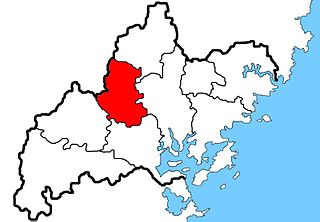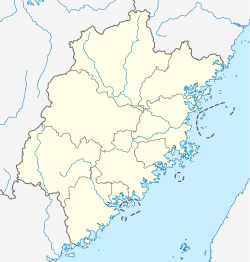
Jiamusi is a prefecture-level city in eastern Heilongjiang province, People's Republic of China. Located along the middle and lower reaches of the Songhua River, it faces Russia's Khabarovsk Krai across the Ussuri River and the Heilongjiang. In 2018, Jiamusi had a GDP of RMB 101.2 billion with a 4.3% growth rate. Its population was 2,156,505 at the 2020 census whom 862,555 lived in the built up area comprising 4 urban districts.

Lishui is a prefecture-level city in the southwest of Zhejiang province, People's Republic of China. It borders Quzhou, Jinhua and Taizhou to the north, Wenzhou to the southeast, and the province of Fujian to the southwest. The name of the city literally means "Beautiful Waters."

Jianyang is a district in the prefecture-level city of Nanping, in the northern part of Fujian province, People's Republic of China. Its population was 2,910,000 in 2013.

Zhongxiang is a county-level city of Jingmen, central Hubei province, People's Republic of China. The name Zhongxiang means "Blessed with propitious omen", and was given to the city by the Jiajing Emperor in the Ming dynasty.

Wafangdian, formerly Fuhsien (Fuxian) or Fu County, is one of the two "northern county-level cities", the other being Zhuanghe, under the administration of Dalian, located in the south of Liaoning province, China. The city is famous for its ball bearing industry. Wafangdian Bearing Factory is the largest bearing manufacturer in Asia and was initially built by the Japanese during World War II. Its area is 3,576.40 square kilometres (1,380.86 sq mi) and its permanent population as of 2010 is 942,197, compared to 1,024,876 registered with hukou permits. The city borders the prefecture-level city of Yingkou to the northeast.

Jixi is a city in southeastern Heilongjiang Province, People's Republic of China. At the 2020 census, 1,502,060 people resided within its administrative area of 22,488.47 square kilometres (8,682.85 sq mi) and 560,118 in its built-up area made up of 3 out of 6 urban districts. Jixi is on the Muling River about 30 km (19 mi) from the border with Russia's Primorsky Krai and 120 km (75 mi) from Lake Xingkai. The mayor of Jixi is Zhang Changrong (张常荣) since June 2015. The area is one of the important coal mining bases in China. A crater on asteroid 253 Mathilde was named after the city.

Shouning County is a small county located in the northeast of Fujian province of People's Republic of China, bordering Zhejiang province to the northeast. It is under the jurisdiction of Ningde City, An Eastern Min dialect of Min Chinese is spoken there.

is a county-level city in northeastern Ningde prefecture-level city, on Fujian's border with Zhejiang province.

Anji County is a county in the prefecture-level city of Huzhou in northwestern Zhejiang province, China. The county spans an area of 1,886 square kilometres (728 sq mi), with a population of 461,800 as of the end of 2013. Located within the Yangtze River Delta, Anji County is a short distance from Shanghai, Hangzhou, and Nanjing.

is a county-level city in Zhejiang Province, China, and under the jurisdiction of Jiaxing. It is in the south side of Yangtze River Delta, and in the north of Zhejiang. It is 125 km (78 mi) to the southwest of central Shanghai, and 61.5 km (38.2 mi) east of Hangzhou, the provincial capital. To its south lies the Qiantang River. The city has a land area of 700.5 km2 (270.5 sq mi) and as of the 2020 census, had a population of 1,076,199 inhabitants. Haining is known for its leather industry and spectacular tide in the Qiantang River. Since June 2021, it's linked to Hangzhou by the new suburban Hangzhou - Haining subway Line.

is a county-level city of Ningde prefecture level city, in northeast Fujian province, PRC, some 150 kilometres (93 mi) North of the provincial capital Fuzhou. Fuzhou and Fu'an of Ningde prefecture along with Cangnan county-level city of Wenzhou prefecture in Zhejiang province make up the Min Dong linguistic and cultural region of China. Fu'an along with Fuzhou and the Eastern Min region are the closest geographically to the nearby Matsu Islands which are an archipelago of 36 islands within the Lienchiang county of Taiwan.
Pingnan County is an inland county in northeastern Fujian province, People's Republic of China. It is located in the cultural region of Mindong (闽东), and lies in the west of Ningde City.

Taining County is a county in the northwest of Fujian province, People's Republic of China. It is the northernmost county-level division of the prefecture-level city of Sanming.

Xiapu is a county in the municipal region of Ningde, Fujian, People's Republic of China, located along a stretch of East China Sea coast, with many harbours and islands. It is bordered by Fuding City and Zherong County to the north, Fu'an City and Ningde's urban area to the west, and Luoyuan County, Fuzhou and the Matsu Islands of Lienchiang County, Republic of China (Taiwan) to the south.

Zherong County is a county in the northeast of Fujian province, People's Republic of China, bordering Zhejiang province to the north. It is under the administration of the prefecture-level city of Ningde.

Zhouning County is a county of northeastern Fujian province, People's Republic of China. It is under the administration of the prefecture-level city of Ningde.

Guangning County, alternately romanized as Kwongning County, is a county in western Guangdong, China, under the administration of the prefecture-level city of Zhaoqing. Guangning County has an area of 2,380 square kilometers (920 sq mi), with a population of 540,000.
The Ningde dialect is a dialect of Eastern Min Chinese spoken in urban areas of Ningde, China, which is a prefecture-level city in the northeastern coast of Fujian province.
She or Shehua is an unclassified Sinitic language spoken by the She people of Southeastern China. It is also called Shanha, San-hak (山哈) or Shanhahua (山哈话). She speakers are located mainly in Fujian and Zhejiang provinces of Southeastern China, with smaller numbers of speakers in a few locations of Jiangxi, Guangdong and Anhui provinces.
Baiyang Township (柏洋乡) is a township -level administrative unit under the jurisdiction of Xiapu County, Ningde City, Fujian Province, People's Republic of China. In 2017, the administrative area was 17,289 hectares, and the permanent population was 10,676


























